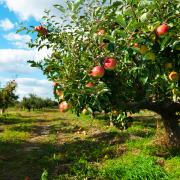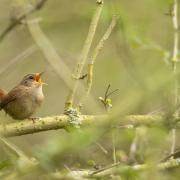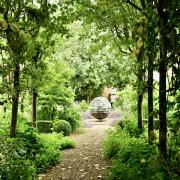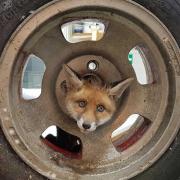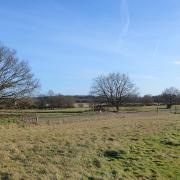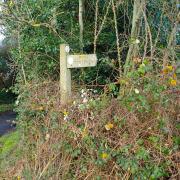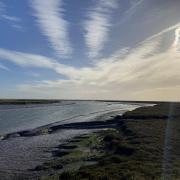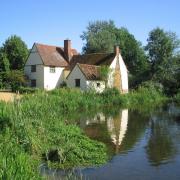When April's arrival brings sunshine and warmth, it’s time to reconnect with nature
It’s hard not to get excited by spring; nature’s alarm clock is waking even the sleepiest of species, fresh buds are emerging, colourful flowers are blooming and wildlife is back to its bustling day job. You can almost feel the energy in the air as the landscape once again becomes a hive of activity, welcoming back migratory species and new life with open arms.
As wildlife reawakens, so do our senses. The countryside becomes awash with vivid meadows and carpets of breath-taking wildflowers, magical birdsong melodies chime into our mornings, as well as the dull buzz of busy insects and the sharp scent of wild garlic drifts in the breeze.
This is the season for new beginnings, so shake off any remaining winter blues, lace up your walking boots and get out to enjoy this zestful season in all its enchanting glory. We will highlight spring’s must-see species and spectacles to look for out of your window, in your garden or at your local nature reserve. We have been patiently waiting for the charms of spring all winter, so don’t miss out on showtime!
Busy ponds
Look for me at Abberton Reservoir Nature Discovery Park
Whether you have a garden pond or you're visiting one in nature, you’ll start to notice pondlife returning this season. Great-crested newts with their yellow spotted underbellies will become active, while dragonflies will hawk and zoom over the pond tops, searching for food. Common toads and frogs will begin to leave their jelly-like spawn – a sign of new life ready to begin.
If you see a toad, please let Essex Wildlife Trust know. These creatures are under threat and becoming increasingly uncommon in Essex. Record your sighting here: essexwt.org.uk/get-involved/campaigns/essex-toads

Boxing hares
Look for me at Blue House Farm nature reserve
Known for their incredible speed, ‘mad March hares’ are also well-known for their boxing abilities. One of the season’s finest spectacles is the energetic display of boxing hares in the springtime. As they stand on powerful hind legs, females will swat away over-affectionate males looking for a partner during breeding season. Look for them across fields, coastal marshes and heathlands in Essex.

Basking adders
Look for me at Fingringhoe Wick Nature Discovery Park
Warmer temperatures are tempting the return of sunbathing serpents. Being cold-blooded, reptiles must warm up using external sources, so keep an out for them basking. One exciting species to add to your list this spring is the adder; this is the UK’s only venomous snake species and can be identified by the striking black zigzag pattern that runs along their length.
Beach-nesting birds
Look for me at Colne Point nature reserve
Did you know that some birds create their nests and lay eggs right on the beach? Within the pebbles and stones, tiny delicate birds’ nests are keeping eggs warm and safe, before little birds can emerge to smell the sea air. Their vulnerable nature means that species that nest on beaches, such as ringed plover, little tern and oystercatcher, are in decline. However, Essex Wildlife Trust has joined forces with the RSPB and Bird Aware Essex to help keep them safe. You can enjoy our coastal birdlife and keep beach-nesting birds safe by respecting zoned-off areas on beaches and spreading the word.
Wonderful webcams
Look for me at essexwt.org.uk/wildlife/webcams
The arrival of spring means a busy season ahead for Essex Wildlife Trust’s webcams. The beloved barn owl that laid nine eggs last year is hoped to return to her usual nesting spot, along with old-time favourite One-Eye as the brood’s father. Keep a close watch on the webcam as the birds begin to settle in. Over at Hanningfield Reservoir Nature Discovery Park, the bat box will see plenty of action as bats begin to roost and hundreds of young soprano pipistrelle bats will be viewable on your screens. If you want to catch up with wildlife in the daytime, why not check out the Trust’s latest webcam? Overlooking the bird feeders and idyllic view of Hanningfield’s reservoir, you could spot long tailed tits, sparrowhawks or even greedy squirrels!
Make your garden wildlife-friendly in six simple steps
1. Re-wild all spaces. Consider adding a green roof to sheds or bin stores, add plant pots and containers on patios and decks and don’t ignore your front garden if you are lucky enough to have one.
2. Keep feeding birds. Continue to feed your garden birds; by mixing up the seed you can attract a variety of visitors.
3. Refill water. Keep the source of water in your garden topped up to help all wildlife.
4. Leave nesting materials. Leave loose piles of twigs, moss and even dog hair for birds to collect for nest-making.
5. Sprinkle seeds. Create a wildflower border, mini meadow or plant a tub with insect-friendly wildflower seed.
6. Leave a quiet corner. Always try to leave some areas undisturbed for little visitors to shelter under.




